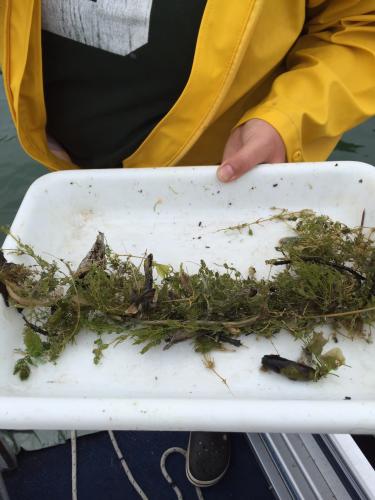MiCorps training aids in early detection of invasive species
It takes many volunteers to help keep Michigan’s lakes and streams healthy. What volunteers found at Eagle Lake in Cass County was a surprise.

Aquatic plant infestations have damaged many inland lakes in Michigan. Locating and identifying exotic aquatic invasive plants (AIS) is crucial in disrupting their spread across a lake. Participating in the Michigan Clean Water Corps (MiCorps) the Exotic aquatic plant watch (EAPW) program of the Cooperative lakes Monitoring program (CLMP) is a great place to start. When enrolled in MiCorps and trained in the CLMP program volunteers learn how to monitor lakes for exotic and native plant species introductions. If AIS are detected, a rapid response strategy can be implemented.
The CLMP is the lake monitoring program of MiCorps. MiCorps was created to assist the Department of Environmental Quality (DEQ) in the collection and sharing of water quality data throughout the state. According to the MiCorps website, “The Michigan Lake and Stream Associations, Inc. (MLSA) has administered the CLMP jointly with the Michigan Department of Environmental Quality (DEQ) under a Memorandum of Understanding. MLSA - in partnership with the Great Lakes Commission, the Huron River Watershed Council, and the Michigan DEQ - continues to support the administration of the CLMP, which is now a component of the MiCorps programming. Michigan State University's Department of Fisheries and Wildlife also supports the partnership with technical assistance, “since 1992. As the water quality director of the Eagle Lake Improvement Association, I volunteered to train in and implement the Michigan Clean Water Corps (MiCorps) CLMP program at our lake. During the training, we were taught how to survey and identify non-native invasive aquatic plant species and various integrated pest management strategies. Following the completion of training local volunteers are recruited from among the lakes’ residence. A date is planned for venturing out on the lake to sample for plants present sometime in June or early July; typically when the weather is warm and the lake is calm.
Monitoring was performed along with several other volunteers on Eagle Lake, a 379-acre lake in Cass County, Michigan. Local CLMP volunteers performed EAPW surveys on two separate dates during the first week of July. Nine different locations were examined. The goal was to inspect 20 locations based on the size of Eagle Lake. Gathering aquatic plants requires throwing an innovative rake head attached to a rope into the water from a boat stationed approximately 14 feet from the target shoreline location. The “plant catch” is pulled up for examination, pictures are taken and to identify the various species collected.

Native Muskgrass and native pondweed found on the north shore of Eagle Lake, Cass County. Photo credit: Lori Mroczek
The expected native species was collected: large leaf pondweed, southern naiad and bladderwort were in our samples. Also found was the non-native invasive species Starry Stonewort in our lake samples; its discovery surprised the volunteers. Eagle Lake was treated over several years for Eurasian watermilfoil. The declining Eurasian watermilfoil population provided the opportunistic Starry stonewort to replace it in the ecosystem. It is unknown how Starry stonewort was brought to Eagle Lake but the most common means is by visiting watercraft.
This discovery was alarming and posed serious situation. Following the five recommended integrated Pest Management Strategies arriving at “Rapid Response”. Volunteers documented all their findings and sent a report along with samples and pictures to Michigan State University Extension for entry in the CLMP database. Professional services were contacted for eradication treatment.
Starry stonewort (Nitellopsis obtusa) is a highly invasive algae that is resistant to conventional water weed treatments. It not only competes with native submerged plants but also other non-native invasive species. Starry stonewort destroys crucial fish spawning habitat. It is commonly found growing in shallow and slow moving deep waters. Starry stonewort has a highly visible characteristic white star like bulbil that makes it identification quite easy.

Starry Stonewort found in Eagle Lake, Cass County on July 13, 2015. Notice the characteristic cream colored bulbil star in the cluster of branches. Photo credit: Lori Mroczek
Were it not for the participation in the MiCorps and CLMP program and the help of the many volunteers at Eagle Lake, this early detection of Starry stonewort might not have been discovered in a timely enough fashion to manage it. With the guidance and education from MiCorps CLMP and trained dedicated volunteers, together the inland lakes of Michigan can be protected from this aquatic invader for generations to come.
For more information about invasive aquatic plants contact me. To learn more about invasive organisms and invasive aquatic plants contact Michigan State University Extension Natural Resources educators who are working across Michigan to provide aquatic invasive species educational programming and assistance. You can contact an educator through MSU Extension’s “Find an Expert” search tool using the keywords “Natural Resources Water Quality.”



 Print
Print Email
Email



